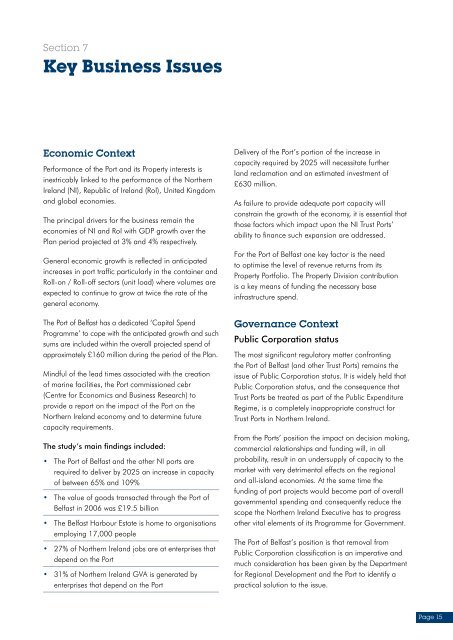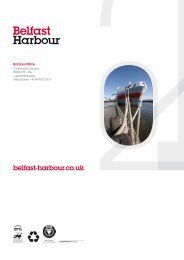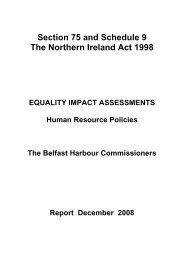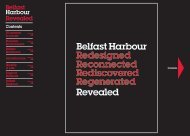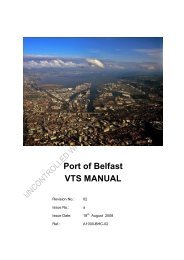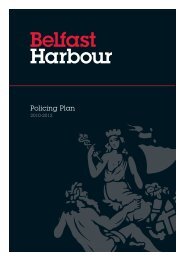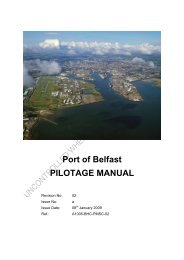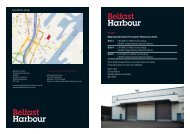Corporate Plan 2008 - 2012 - Belfast Harbour
Corporate Plan 2008 - 2012 - Belfast Harbour
Corporate Plan 2008 - 2012 - Belfast Harbour
You also want an ePaper? Increase the reach of your titles
YUMPU automatically turns print PDFs into web optimized ePapers that Google loves.
Section 7<br />
Key Business Issues<br />
Economic Context<br />
Performance of the Port and its Property interests is<br />
inextricably linked to the performance of the Northern<br />
Ireland (NI), Republic of Ireland (RoI), United Kingdom<br />
and global economies.<br />
The principal drivers for the business remain the<br />
economies of NI and RoI with GDP growth over the<br />
<strong>Plan</strong> period projected at 3% and 4% respectively.<br />
General economic growth is reflected in anticipated<br />
increases in port traffic particularly in the container and<br />
Roll-on / Roll-off sectors (unit load) where volumes are<br />
expected to continue to grow at twice the rate of the<br />
general economy.<br />
The Port of <strong>Belfast</strong> has a dedicated ‘Capital Spend<br />
Programme’ to cope with the anticipated growth and such<br />
sums are included within the overall projected spend of<br />
approximately £160 million during the period of the <strong>Plan</strong>.<br />
Mindful of the lead times associated with the creation<br />
of marine facilities, the Port commissioned cebr<br />
(Centre for Economics and Business Research) to<br />
provide a report on the impact of the Port on the<br />
Northern Ireland economy and to determine future<br />
capacity requirements.<br />
The study’s main findings included:<br />
• The Port of <strong>Belfast</strong> and the other NI ports are<br />
required to deliver by 2025 an increase in capacity<br />
of between 65% and 109%<br />
• The value of goods transacted through the Port of<br />
<strong>Belfast</strong> in 2006 was £19.5 billion<br />
• The <strong>Belfast</strong> <strong>Harbour</strong> Estate is home to organisations<br />
employing 17,000 people<br />
• 27% of Northern Ireland jobs are at enterprises that<br />
depend on the Port<br />
• 31% of Northern Ireland GVA is generated by<br />
enterprises that depend on the Port<br />
Delivery of the Port’s portion of the increase in<br />
capacity required by 2025 will necessitate further<br />
land reclamation and an estimated investment of<br />
£630 million.<br />
As failure to provide adequate port capacity will<br />
constrain the growth of the economy, it is essential that<br />
those factors which impact upon the NI Trust Ports’<br />
ability to finance such expansion are addressed.<br />
For the Port of <strong>Belfast</strong> one key factor is the need<br />
to optimise the level of revenue returns from its<br />
Property Portfolio. The Property Division contribution<br />
is a key means of funding the necessary base<br />
infrastructure spend.<br />
Governance Context<br />
Public Corporation status<br />
The most significant regulatory matter confronting<br />
the Port of <strong>Belfast</strong> (and other Trust Ports) remains the<br />
issue of Public Corporation status. It is widely held that<br />
Public Corporation status, and the consequence that<br />
Trust Ports be treated as part of the Public Expenditure<br />
Regime, is a completely inappropriate construct for<br />
Trust Ports in Northern Ireland.<br />
From the Ports’ position the impact on decision making,<br />
commercial relationships and funding will, in all<br />
probability, result in an undersupply of capacity to the<br />
market with very detrimental effects on the regional<br />
and all-island economies. At the same time the<br />
funding of port projects would become part of overall<br />
governmental spending and consequently reduce the<br />
scope the Northern Ireland Executive has to progress<br />
other vital elements of its Programme for Government.<br />
The Port of <strong>Belfast</strong>’s position is that removal from<br />
Public Corporation classification is an imperative and<br />
much consideration has been given by the Department<br />
for Regional Development and the Port to identify a<br />
practical solution to the issue.<br />
Page 15


